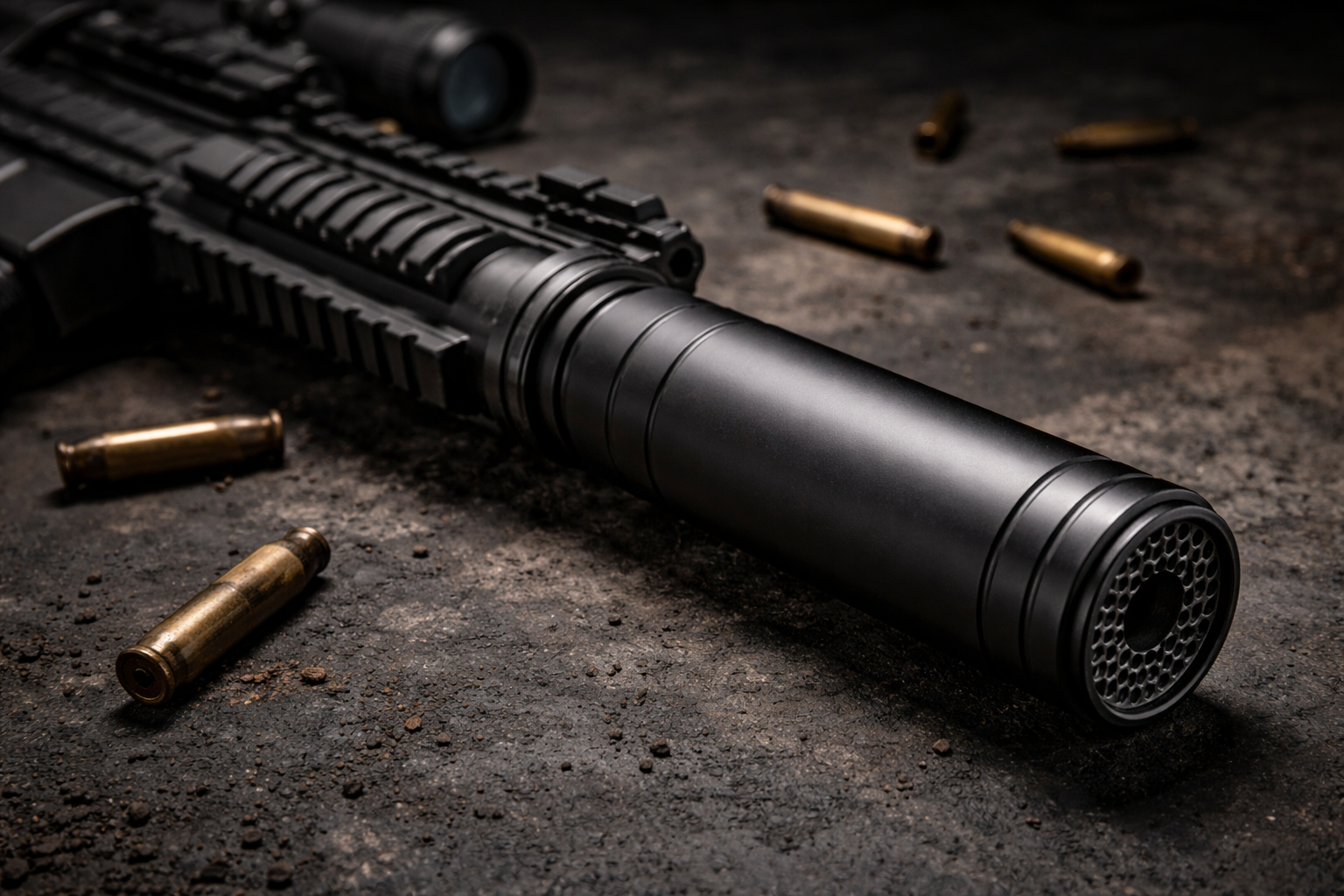Sssshhhhh, lets be quiet!
Brendan O'Neil Jul 07, 2025
The Complete Guide to Suppressors: Myths, Mechanics, and Modern Use
Suppressors, often mistakenly called "silencers," are one of the most misunderstood accessories in the firearms world. Popular media has painted them as whisper-quiet tools used primarily by secret agents and criminals, but the truth is far more practical. Suppressors are legal in many parts of the United States and other countries, and they serve several important functions—most notably hearing protection, recoil reduction, and improved shooting accuracy.
In this blog post, we’ll dive deep into what suppressors are, how they work, the benefits they offer, their legal status, and the misconceptions that surround them.
What Is a Suppressor?
A suppressor is a device attached to the muzzle of a firearm to reduce the noise and visible muzzle flash generated when the weapon is fired. Technically, the term “suppressor” is more accurate than “silencer,” as it describes the device’s true function: suppressing sound, not eliminating it entirely.
Suppressors work much like the muffler on a car. When a firearm is discharged, it produces extremely hot and high-pressure gases that expand rapidly as they leave the barrel. This rapid expansion creates the characteristic gunshot "crack." A suppressor redirects and contains these gases through a series of internal baffles, allowing them to cool and decelerate before exiting the muzzle. The result is a noticeable reduction in noise, though the firearm is still far from silent.
The Science Behind Suppressors
To understand how suppressors work, it’s helpful to look at the physical mechanics involved when a gun is fired:
- Propellant Explosion: When the trigger is pulled, the firing pin strikes the primer, igniting the gunpowder in the cartridge. This produces a high-pressure gas that forces the bullet down the barrel.
- Muzzle Blast: As the bullet exits the barrel, the hot gases follow, rapidly expanding into the atmosphere and creating a loud report.
- Sonic Crack: If the bullet is supersonic (faster than the speed of sound, around 1,125 feet per second), it creates a secondary loud "crack."
A suppressor addresses two of these three sources of noise: the muzzle blast and the expanding gas. It cannot suppress the sonic crack of a supersonic bullet. However, when paired with subsonic ammunition—which travels below the speed of sound—the suppressor can significantly reduce the firearm's noise signature.
Key Benefits of Using Suppressors
Suppressors are not just for tactical teams or movie spies—they offer real-world advantages for everyday shooters, hunters, and firearms enthusiasts.
1. Hearing Protection
Repeated exposure to gunfire, even with traditional hearing protection, can lead to permanent hearing damage. A suppressor can reduce the sound of a gunshot by 20 to 35 decibels, depending on the caliber and ammunition. That’s equivalent to the difference between a jackhammer and a lawn mower.
Suppressors make shooting safer for both the shooter and those nearby. They are particularly valuable in environments where hearing protection is impractical—such as in the field during hunting or for training new shooters who may struggle with ear protection.
2. Improved Accuracy
Suppressors reduce felt recoil and muzzle rise, helping shooters stay on target for faster follow-up shots. This stability improves accuracy and can lead to more ethical hunting kills and better performance during competitive shooting.
3. Reduced Muzzle Flash
Suppressors can also diminish the visible muzzle flash, which can be helpful in low-light environments. While not a critical benefit for most civilian users, it can be useful in home-defense scenarios where blinding flash may impair night vision.
4. Enhanced Shooting Experience
By making firearms quieter and reducing recoil, suppressors provide a more comfortable and less intimidating shooting experience. This is especially helpful when introducing new shooters to firearms.
Common Myths About Suppressors
Thanks to decades of Hollywood misrepresentation, there are plenty of myths and misconceptions about suppressors. Let’s debunk a few:
Myth 1: Suppressors Make Guns Silent
Fact: Even with a suppressor, most firearms still produce significant noise—often between 120 and 140 decibels. That’s quieter than the unsuppressed average of 160 dB but still loud enough to require caution. The only time you get something close to "movie-quiet" is with a suppressed .22LR using subsonic rounds.
Myth 2: Suppressors Are for Criminals
Fact: Suppressors are heavily regulated and rarely used in crimes. According to a 2017 report by the Bureau of Alcohol, Tobacco, Firearms and Explosives (ATF), suppressors are used in a tiny fraction of firearm-related crimes. Criminals prioritize concealability and cost—two things suppressors hinder.
Myth 3: Suppressors Eliminate the Need for Ear Protection
Fact: While suppressors reduce noise, they don’t always bring it below the safe hearing threshold. Combining a suppressor with earmuffs or earplugs remains best practice, especially for high-powered firearms.
Legal Landscape of Suppressors
In the United States, suppressors are legal in 42 states for private ownership and 41 states allow their use for hunting. However, they are regulated under the National Firearms Act (NFA) of 1934, meaning their purchase involves a strict and lengthy process.
How to Legally Buy a Suppressor in the U.S.:
- Find a Licensed Dealer: You must purchase from a Federal Firearms License (FFL) holder with a Special Occupational Taxpayer (SOT) status.
- Submit ATF Form 4: This form includes fingerprinting, a passport photo, and a $200 tax payment. It can take several months to process.
- Background Check & Registration: The suppressor is registered to you or your legal entity (like a trust). You must notify the ATF of any future transfer or interstate movement.
State-Level Restrictions:
- Completely banned: California, Illinois, Hawaii, New York, New Jersey, Delaware, Rhode Island, Massachusetts, and the District of Columbia.
- Hunting restrictions: Some states allow suppressor ownership but restrict their use in hunting.
Efforts have been made over the years to deregulate suppressors, such as the Hearing Protection Act, which aimed to remove them from NFA regulation. While the bill has not passed into law, it reflects a growing awareness of suppressors’ practical value.
Choosing the Right Suppressor
If you're interested in purchasing a suppressor, several factors should guide your choice:
1. Caliber Compatibility
Ensure the suppressor is rated for the caliber you plan to use it with. Some models offer multi-caliber compatibility, while others are caliber-specific.
2. Material
Suppressors are made from various materials including aluminum, steel, titanium, and Inconel. Each offers different trade-offs in weight, durability, and heat resistance.
3. Mounting System
Suppressors can be direct-threaded or use quick-detach (QD) mounts. QD systems allow faster installation and removal, while direct-thread mounts may offer more consistency and accuracy.
4. Length and Weight
Heavier and longer suppressors provide more noise reduction, but may be less practical for hunting or maneuvering in tight spaces. Choose one that balances suppression with handling.
5. Maintenance
Some suppressors are user-serviceable, meaning they can be disassembled for cleaning. This is particularly important if you're using .22LR or other dirty ammunition.
The Future of Suppressors
As more people become educated about the benefits of suppressors and their relatively low risk of misuse, there’s growing public and legislative support for loosening regulations. Organizations like the American Suppressor Association (ASA) advocate for suppressor rights and work to correct misconceptions.
Internationally, suppressors are far more accepted. In countries like Norway, Finland, and New Zealand, they are considered standard safety equipment and often require no special paperwork to own.
Conclusion
Suppressors are practical tools with real benefits: they protect hearing, improve accuracy, reduce recoil, and enhance the overall shooting experience. Far from being the weapon of choice for criminals, suppressors are used by responsible hunters, sport shooters, and firearm owners seeking a safer, quieter shooting environment.
While regulations around suppressors remain strict in the U.S., knowledge and public perception are slowly shifting. As more people understand their purpose and advantages, suppressors are moving out of the shadows and into the mainstream of responsible gun ownership.
Whether you're a seasoned shooter or a curious newcomer, learning about suppressors is a step toward smarter, safer, and more enjoyable shooting.


North Wilkesboro Clemmons